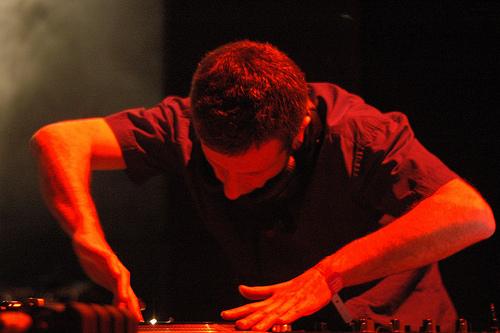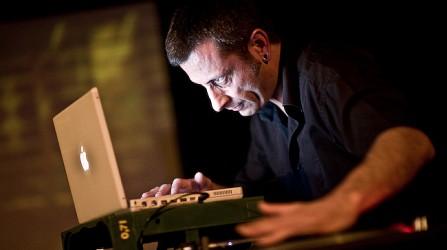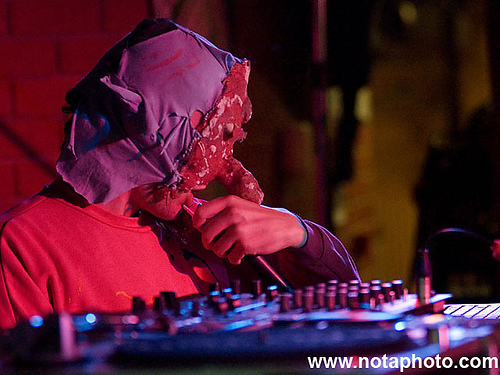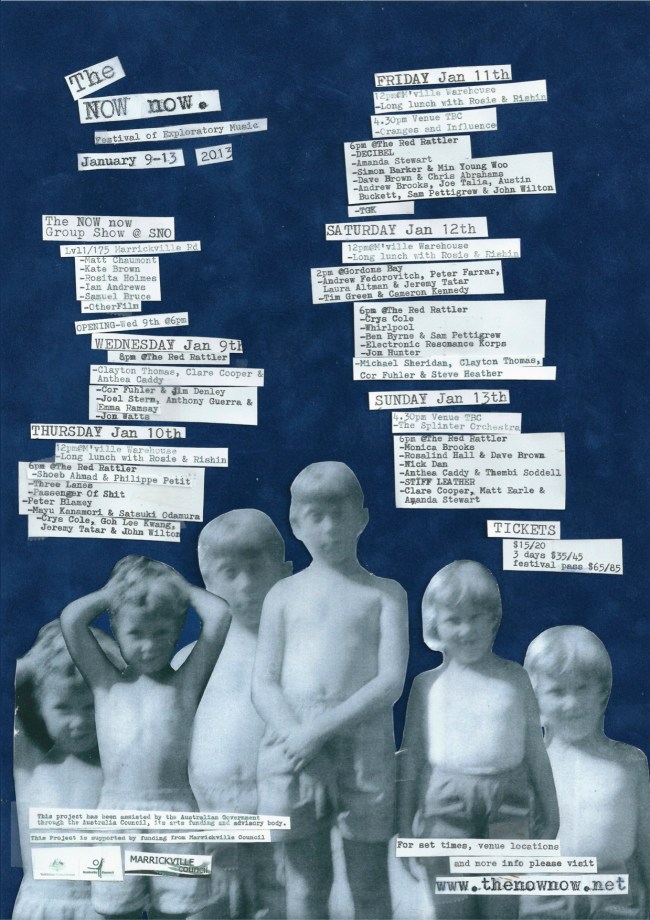 January
12
January
12
Tags
The NOW now right now – Day 2 (festival review)
Well, if there’s one thing we all know for sure now, it’s that the Now now is a mighty big festival. The music is huge and every set a series of highly accomplished musicians doing what they do so well. There is pretty much no chance of sticking to the timetable, which means (unfortunately) for this little reviewer, not much chance of making everything. I’ll be able to get to more on the weekend but Thursday night saw me miss a couple of key events due to deadlines and Friday night will see me miss other due to prior commitments. (Hoping to straggle in later tonight in the wee small hours though.)
Last night I got to chatting with some other audience members around me and all the feedback is an excited positive. It’s hard not to be effected when the music is this good. The crowd floated in and out a little more on the second night, spilling more into the roads around the rattler and generally making it their home over the next few nights. I took a couple of photographs, but the great news is I won’t be posting them. Truly – you just can’t imagine how bad I am at that.
I was able to catch the end of the first set, a trio going by the name of Three Lanes consisting of Andrea Keller (piano), Genevive Lacy (recorders) and Joe Talia (revox and percussion) but wasn’t there in time to get any decent notes. The music was lilting and beautiful, Genevive Lacy is something of a celebrity in the music world down here.
What I was early enough to catch was the amazing Phillip Petit (turntables) playing with Shoeb Ahmad (Guitar and electronics). There is not much that can prepare you for the extraordinary skills of Petit, but I’ve added and ancient video (ancient being him playing in 2011) to give you a bit of a taste. This was a performance I hadn’t seen the likes of before. The first set started with Petit on his computer producing an electro grinding swell sustained by beats in the background producing a rising pulse of sound. This moves swiftly into a slither of a noise that then slipped up and down scales moving into sliding scales. All the while the background is haunted – implying a kind of buried sound giving weight to the strength of the slippery electronics. Because of this layering, notes were free to waver from their source, as if they would leap at freedom and scramble to find their place on the register again. At times the sound was underwater, as if the listener is in a submarine or a submerged experience. Sonic and potent. Music that can be felt. The swell rises like a bubble that burst through to a loud, phantasmagorical bubble burst of eclectic sound. After this its a power-fest as the sound scratches and writhes its way out of whatever that submerged place was. Soon Petit introduced radio sounds that give the impression of a subterranean space again… I kept feeling my listening was holding me in a submarine that would at brief moments allow for a surface burst, or a strong ray of hot sunshine making its way to me. Petit’s voice comes in here and it sounds less human than the machine. Soon muted screams herald the next burst in a relentless pulse that quickens and then relaxes. Soon the frantic voice stills and after keeping pace with the sonic wilds. Soon the sound will slide into a hunted silence… eventually …cut off.
In the second set, Ahmad’s guitar is added to the powerhouse of sound Petit offers. Again the start was ambient in nature as if the listener needed to be brought into the pulse gradually. Against these electrics the guitar sounded almost tarnished, branded and earth-bound. The electronics from each musician stood in a potent contrast that the listener felt almost in the middle of. The feeling here again was of being submerged. Petits voice sounded like animals of some other world, making their way around and over the hovering listener. The guitar with its distorted recognitions acted as an anchor, a point of the familiar with which a play into the unknown can be made. Melody from the electronics would break through the swell using a kind of repetition for opposites of sound: loud and soft, peace and turbulence. The sound got to the point that it seemed as though its opposite was contained within it.
Soon the sonic booms turn more toward a thumping sound that burst through the peace with shrill noises of overpowering distress. Ahmad’s guitar still held our hand as if it could lead us to melody without ever arriving. By this time Petit has hit the turntables in an harmonious scratch and twist that sits lightly over the pounding electrics and the relentless guitar. Soon the turntables become attacks of sound. The pounding is lost to the scratches of sound. Ahamed brings feedback into the sound scape and the bloods rush pounded in my ears. Petit isn’t just a sound player. His is a visual performance, turning and twisting his body with the music, I have an image 0f his arms, elbows bent at right angles, hands spread wide over the turntables, his body twisting and writing along with the music. The turntables pluses deep within the psyche so that the sound is deeply personal. Petit seems able to cut out the space between me and the performance, involving my senses deeply. The two musicians combined move the listener away from their surrounds and into an alternate state, evoked by the music. Soon a voice comes in and Petit slows it down and speeds it up and I am swept along with its perfectly timed immediacy. The musicians will take us from loud, to very loud to louder still here, but somehow I felt prepared to open up completely to the music. Soon after there is a window again into the ambient space that allows for the undercurrent we realise has always been there to come to the fore again. A siren scream calls the alarm and the sound petered down as the turntables crackle and make their way into silence.
Passenger of Shit – Trendy Core #13
The second set I was able to catch in full is Passenger of Shit, the enormously popular shitcore (badass-mother-fucker) Experimental Hardcore , Gabba , Speedcore , Breakcore , Terrorcore , Noise , Carnival Themes , Amiga demo mod scene style , Happy hardcore , Old school rave , Digital Grindcore and Gore/Porngrind Techno DJ. Some of the folk in the room were able to dance, but this was a room filled with seated folk come to hear the music – which Passenger of Shit did make a comment on first. There wasn’t really the room for dance, so we listened and gave our everything undiluted to be ravaged by Passenger of Shit. I have a nice little sample set aside for you above which is probably the best way to describe this music, as it’s not my usual area covered by my reviews. This isn’t to say I didn’t enjoy it. There’s too much talent not to love what’s being done here and the surprise for the open listener is the deep sensuality of shitcore – or perhaps its just Passenger of Shit himself. It was an incredibly sexy performance (he wore a mask that looked like either vomit or a very loose turd falling over his face) exuding passion and a dark distortion of sexuality through scatological referencing. You need to be nicely open for this one…I reckon the response might be a tad frighting if you aren’t prepared for the Battialle-esque sensuality of it all.
I was only able to stay for one more set on this evening, and that was the divine performance by Mayu Kanamori (photography & projections) and Satsuki Odamura (koto & bass koto) which was an exquisite blend of the relationship between sound and image. (from the press page on her website) Satsuki Odamura is a master of the Koto. She is the representative of the Sawai International Koto School and has pioneered the introduction of teaching and performing on this ancient Japanese instrument to students, teachers and audiences since her arrival in Australia. Satsuki herself began learning the koto when she was ten. She joined the Sawai Koto School of Music in Tokyo when she was 18 and underwent the disciplines of being a live-in student with her teachers Tadao and Kazue Sawai. This has influenced her approach to performance and collaboration with the other artists. On this particular night, we watched her perform with Mayu Kanamori. (from the wiki on Mayu) Mayu Kanamori is an artist working mostly in photography, documentary photography, and still photography video art, often using photographic projection and story telling with emphasis on performance using interviews and narration. Kanamori’s earlier works deal with themes relating to subculture and minority groups, especially within Japan and Australia. Her later works deal with Australian and Japanese cross cultural and migrational issues, and her more recent works further these concerns by her attempt to spiritual connections with people and landscapes of both Australia and Japan.
This performance was as fascinating as you would expect from the above information. The overwhelming feeling of this set was music as and of connection. Mayu sang whispered words and spoke lines of poetry to the Koto playing in the background before the background lit up with a combination of montage and still photos. At this point in the performance, as Odamara’s Koto plays and performs, Kanamori used her camera to speak to the audience. The photos she took would show up almost instantly on the combination of white wall and white baby grand piano behind the two performers. Initially Kanamori took shots of the Koto so that we could not only see where the hand has been but also where it is going. The connection between the two artists infused the room with a deep intimacy and drew every listener into the performance. Sometimes there was a pause in the shots and the image of a listener would appear on the screen. One of us. We were part of the performance as the sound and the image drew us closer to everyone in the room. When a collection of images was apparent, Kanamori would flow through them – not fast enough for the images to flow as in a film – but fast enough to create a whirlwind around the listener as subject and participant in the set. Odamara followed the lead of the images, adjusting and moving the Koto sound with the image as it presented itself. The listener wasn’t audience. They were a collaborator, another member of the ensemble.
There was more more more on the night, but I was called away and had to leave.



